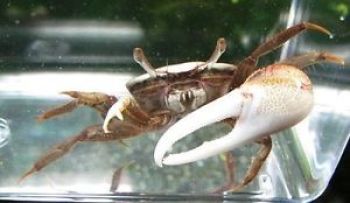Fiddler Crab
Category: Crab

Facts about Fiddler Crab, "Scientific name for Fiddler Crab is Uca pugnax". Fiddler Crab is one among the 100 varieties of semi-earthly sea crabs that belongs to the Uca genus of the Ocypodidae family. The Fiddler Crabs are closely associated with the ghost crabs of the Ocypode genus. The Fiddler Crab are largely found along seashores and salty inter-tidal sludge flats, swamps and lagoons in the Western Atlantic, West Africa, the Indo-Pacific and the Eastern Pacific, and the Fiddler Crab are easily identified by their unique asymmetric claws. The motion of the smaller claw from floor to mouth during nourishing explains the common name of the Fiddler Crab. It looks as though if the creature is playing the bigger claw like a fiddle.
Features
The Fiddler crab is a small size crab that can grow to a maximum of 2 inches (5 cm) across the carapace. The Fiddler Crabs are more popular for their sexually different claws. Generally, the major claw of the male Fiddler Crab is bigger than its minor claw, whereas for the female Fiddler Crabs, both major and minor claws are about the same size.
Similar to all crabs, the Fiddler crab sheds its shell as it grows. If the Fiddler Crabs have lost claws or legs during their current development cycle, a fresh one will be present while they molt. If the big fiddle claw is lost, male Fiddler Crabs will have a fresh one on their opposite side subsequent to their next molt. Recently molted crabs are extremely susceptible due to their flexible shells. The Fiddler Crab are isolated and hide, pending the latest shell becomes firm.
Usually, male Fiddle crabs have an extra-large chela or claw, which is used during fights in the ritualized battle of courtship over a female crab and signal their purposes between non-species. The smaller claw of the Fiddler crab lifts a portion of the residue from the ground and brings it to its mouth, where the contents are filtered. After anything safe to eat is salvaged, the residue is restored in the form of a small ball. The availability of these residue balls close to the entrance to the burrow is a good signal of its occupation. The feeding habits of the Fiddler Crabs play an important role in the conservation of marshland environments by separating through the sands, and they expose the substrate and put off anaerobic conditions.
Diet
The Fiddler crab is a detritivorous creature, and it feeds on anything safe to eat, including microbes, algae, fungus, or other decomposing detritus.
Behavior
Fiddler crab varieties correspond through a sequence of gestures and waves. Male Fiddler Crabs employ the major claw to carry out a waving show as a form of female courtship. Female Fiddler Crabs decide their mate derived from the size of their claw and the quality of the waving exhibit, as well. Usually, the female crab engages the burrow of their mate for laying her clutch of eggs. Generally, the width of the burrow of the Fiddler Crabs is correlated with the size of the major claw of the male crab. So, the female Fiddler Crab will decide a male companion whose claw size designates the best burrow, setting for her clutch of eggs.
The average lifespan of the Fiddler crab ranges from two years to three years.

 Back To Category Crab
Back To Category Crab